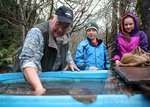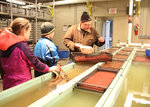

For decades, Errol Anderson collected pea-sized pink coho salmon eggs from state hatcheries and put them in his remote site incubators near Adna, raising 3 million fish in an effort to help dwindling salmon populations.
Errol died in May of this year after battling cancer, and now his family has taken it upon themselves to continue his efforts.
Two of Anderson’s great-grandchildren, Evie Anderson-Thomas and Lane Johnson, both 10 years old and fourth-graders at Adna, went with Errol’s son, Jim Anderson, and his long-time friend and salmon conservation assistant LeeRoy Wisner to pick up hatchery eggs Thursday.
While Evie and Lane were happy for a day off school, they plan on doing a class presentation on their work, and recognize the importance and uniqueness of their opportunity.
“We’re carrying the (project) on,” Evie said.
They arrived at the Washington State Department of Fish and Wildlife’s hatchery on the Skookumchuck River in South Thurston County at 9 a.m. Thursday.
“I loved working with your (great) grandpa,” Jim Dills, hatchery manager, told the kids when they got to the hatchery.
Jim Anderson said while the family has helped out with the conservation project in varying degrees, it was his first time to the hatchery.
“This is new territory for me,” he said.
Dills explained that the eggs have to have a fish eye, a dark speck in the pink sphere, before they can be transported. If they’re handled before that, they won’t survive.
Evie and Lane soaked gunny sacks in the water where trays of 25,000 fish eggs each sat.
Dill then poured the eggs into the sacks, where the eggs can survive for about five or six hours.
Errol had been collecting fish eggs from the Skookumchuck Hatchery since 2009.
Before that, Wisner said, they got eggs from the hatchery at Bingham Creek.
Wisner began helping with the project when Anderson got sick about 10 years ago.
The project is one of only a few to rear salmon outside of the state hatcheries. Wisner said typically projects similar to Errol’s are done by high schools.
“Errol got scared the state would stop the project,” Wisner said about his friend’s declining health and the state’s increased bureaucracy.
Errol took over the project more than 30 years ago from the Westport Trollers Association. The project now has four incubators on Deep Creek tributaries near Adna, which eventually flow into the Chehalis River and to the ocean.
Each year, Errol, and now Wisner and Errol’s family, split 100,000 eggs between the four incubators made out of plastic livestock troughs that are part-way filled with a floor of rocks about 2 inches in diameter and topped with creek water that flows through the system.
“It’s so critical that we keep the water moving,” Jim Anderson said, when they had reached one of the boxes near Adna with the eggs.
Once the eggs hatch and reach the small fry stage, Wisner said, they will release them into the river.
Wisner and Errol’s family will monitor the incubators until the salmon reach that stage and carry on Errol’s conservation efforts as long as they can.
“I hope we keep getting to do this,” Jim Anderson said.